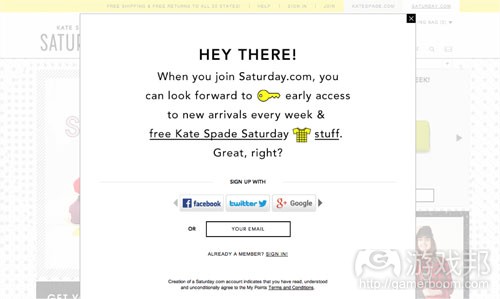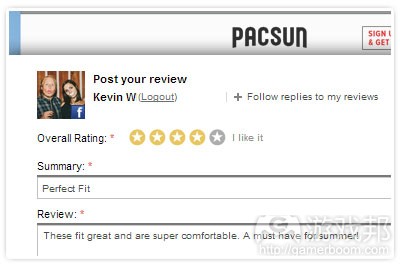关于个性化用户体验的10个诀窍
作者:Emma Tzeng
有时候,投资于真正的用户理解的策略就像是一头钻进一个让人畏惧的深渊。这种绝对的不确定性足以将你带回大众营销活动与非定制数字体验的黑暗时代。
为了帮助你掌握通用的市场营销信息,我们列举了10个简单的窍门去引导你开始走上个性化的旅程。
1.利用社交媒体去获取并创建用户配置
大多数业务已经将社交媒体当成吸引用户与创造品牌意识的方法,但许多人可能不知道像Facebook,Twitter以及Google+等社交供应商包含了无数用户配置数据点,如名字,电子邮件地址,兴趣,喜好,朋友,位置等等你能够传达给第三方网站去生成定制数字体验的内容。社交登录机制将加速这一过程,创造用户的社交媒体体验与其余网页内容间的无缝联系。
以下表格比较了传统注册形式与基于社交媒体配置的用户洞察力、
(来源:Gigya,2013)
2.不要提出比所需更多的要求
在2010年,83%的消费者将“透明和诚实的定价”当成建立品牌信任的最重要元素。为了从头开始建立消费者信任,你就应该避免要求你的用户分享更多不必要的信息,特别是在刚注册的时候。
3.提供比能够得到的还多的内容
为了获得更多消费者的信息,你会提供利益去吸引他们注册你的网站并与之进行交流。
就像Kate Spade Saturday便在这方面做得很好,即清楚地告诉用户在Saturday.com上注册一个帐号的好处。
4.整合cookie数据与第一方社交数据
对于许多市场营销策略来说,为了实现完整的cookie数据,它们应该使用推断式洞察力去定制数字体验,从而在提到实现用户理解时留下更多可期待的内容。通过整合第一方洞察力(游戏邦注:源自社交登录,如用户的生日,兴趣,签到,活动等)到用户体验中,你便能够提供更加完整的网站体验。
5.通过用户经常使用的设备去触及他们
去年,eMarketer发现人们花在手机上的时间第一次超过台式机。
为了突出这一点,研究表明67%的用户更有可能从手机友好型网站上购买产品或服务,74%的用户更有可能成为手机友好型网站的回头客。
如今,触及用户意味着在他们常使用的设备上拥有一个强大的存在感。在这方面,业务将吸引更多想要手机优化体验的消费者。
6.跨越渠道统一你的用户体验
关于我们之前的要点,消费者是同时基于手机和台式机与品牌进行互动,这将让收集并巩固用户配置的业务变得复杂化。实际上,54%的市场营销网站不具有跨越渠道的消费者的单视图,而这将成为创造一个成功的跨渠道体验的最大障碍。
业务想要跨越不同设备创建或投资一个能够统一各种用户配置和行为数据点的平台。当你增建跨渠道用户配置时,你将能够通过获取消费者在网页和手机设备上的行为而更加了解他们。
7.停止发送大量的邮件
为了通过电子邮件内容推动转换率的提升,业务需要为适当的用户定制适当的信息。在第一次收集用户数据并使用这些洞察力根据兴趣,位置等可行信息去划分用户,你便能够针对消费者独特的配置去个性化电子邮件信息,就像下方NFL.com所做的那样。
8.培养品牌主张,而不只是消费者
根据AdAge,55%至60%的千禧一代人想要看到品牌去帮助他们连接并与品牌用户进行分享。这对于致力于培养积极用户品牌(通过分享相关网站内容和活动)的业务来说是个新的好消息。
通过在你的门户网站中整合社交插件,你可以通过让最有价值的消费者在自己的社交网站上推广你的品牌而增加品牌的曝光率。
9.让用户做出评论
平均看来,让消费者与评级和评论进行互动的策略将拥有105%的转换率。通过在你的门户网站上整合评论机制能够邀请消费者为你的内容留下实时反馈,就像下方PacSun所做的那样。
10.将市场营销当成是培养关系的工具
在今天的超连接消费者间,所有的品牌体验都是基于关系。一份来自Forrester的报告指出,有超过一半的美国成人期待在网上看到某种类型的社交市场营销体验。通过登录名字识别消费者,基于他们的兴趣喜好和过去的行为定制网站体验,并发送定制电子邮件到他们的邮箱中能够推动1对1的关系的发展。
我们承诺只要你能够遵循这些诀窍,你的消费者一定会喜欢并支持你的业务。
(本文为游戏邦/gamerboom.com编译,拒绝任何不保留版权的转载,如需转载请联系:游戏邦)
10 quick tips to personalize the customer experience
by Emma Tzeng
Sometimes, taking the leap to investing in a strategy for true customer understanding can feel like diving head-first into a deep, daunting hole. The sheer uncertainty of it all is nearly enough to set you back on the path to the dark ages of mass marketing campaigns and untailored digital experiences.
To help you navigate your way out of generic marketing messages, we’ve mapped out 10 simple tips to get you started on your journey to deep personalization.
1. Leverage social media to capture and build user profiles
Most businesses already use social media as an outlet to engage customers and build brand awareness, but what many probably don’t know is that social providers like Facebook, Twitter, and Google+ contain tons of user profile data points such as names, email addresses, interests, likes, friends, locations, and more that you can pass on to third-party sites to generate tailored digital experiences. Social login facilitates this process, creating a seamless bridge between users’ social media experiences and the rest of the web.
The chart below compares the data captured via traditional registration forms with the user insights that social media profiles contain.
(Source: Gigya, 2013)
2. Don’t ask for more than you need
In 2010, 83 percent of consumers named “transparent and honest practices” as the most important element to establishing brand trust. To establish consumer trust from the outset, you want to avoid asking your users to share more information than necessary, especially during registration.
3. Give more than you take
To capture more customer identities, you want to provide benefits to registering with your site and communicate them clearly when prompting users to register and login.
Kate Spade Saturday, for instance, does a great job of telling users the benefits of registering for an account on Saturday.com.
4. Incorporate cookie data with first-party social data
As integral as cookie data is to many marketing strategies, using inferred insights to tailor digital experiences leaves much to be desired when it comes to complete customer understanding. By incorporating first-party insights garnered from social login such as users’ birthdays, interests, check-ins, activities, and more into your user experiences, you can provide a much more holistic site experience.
5. Reach customers on the devices they use regularly
Last year, eMarketer discovered that time spent on mobile surpassed desktop usage for the first time in history.
To highlight this point, research shows that 67 percent of users are more likely to purchase a product or service from a mobile-friendly site, and 74 percent are more likely to return to a site in the future if it’s mobile-friendly.
Nowadays, reaching customers means having a strong presence on the devices they use the most. In this vein, businesses looking to engage more customers will want to provide mobile-optimized experiences.
6. Unify your user experiences across channels
To our previous point, customers are interacting with brands on both mobile and desktop devices, which can complicate things for businesses seeking to collect and consolidate user profiles. In fact, 54 percent of marketers cite not having a single view of customers across channels as the biggest roadblock in creating a successful cross-channel experience.
Businesses will want to build or invest in a platform that can unify the various profile and behavioral data points collected on customers across devices. As you build out cross-channel user profiles, you’ll gain a more accurate, holistic view on the customer by garnering insights on his or her behaviors both on the web and mobile devices.
7. Stop sending mass email
To drive more conversions through email content, businesses need to craft the appropriate messages for the right audiences. By first collecting data on users and using these insights to segment audiences based on actionable information such as interests, locations, and more, you can personalize your email messages to your customers’ unique profiles, as NFL.com does in the example below.
8. Nurture brand advocates, not just customers
According to AdAge, 55 percent to 60 percent of millennials want brands to help them connect and share with brand audiences. This is great news for businesses looking to nurture loyal customers that actively advocate for their brand by sharing relevant site content and activities.
By incorporating social plugins throughout your web properties, you can drive brand exposure and trust by letting your most valuable customers promote your brand via their social networks.
9. Pull audiences into the conversation
On average, conversion rates are 105 percent higher for consumers that interact with ratings and reviews. Invite customers to leave real-time feedback on your content by incorporating reviews and comments throughout your web properties, as retailer PacSun does in the example below.
10. Treat marketing as relationship-building
Among today’s hyper-connected consumers, all brand experiences are relationships. A Forrester report reveals that over half of U.S. adults expect some sort of social marketing experience online. Facilitate 1-to-1 relationships with customers by identifying them by name upon login, tailoring site experiences based on interests, likes, and past behavior, and sending personalized email communications to their inboxes.
We promise that your customers will only love and advocate for you all the more for it.(source:venturebeat)
上一篇:分析玩家离开F2P游戏的5大原因












































 闽公网安备35020302001549号
闽公网安备35020302001549号